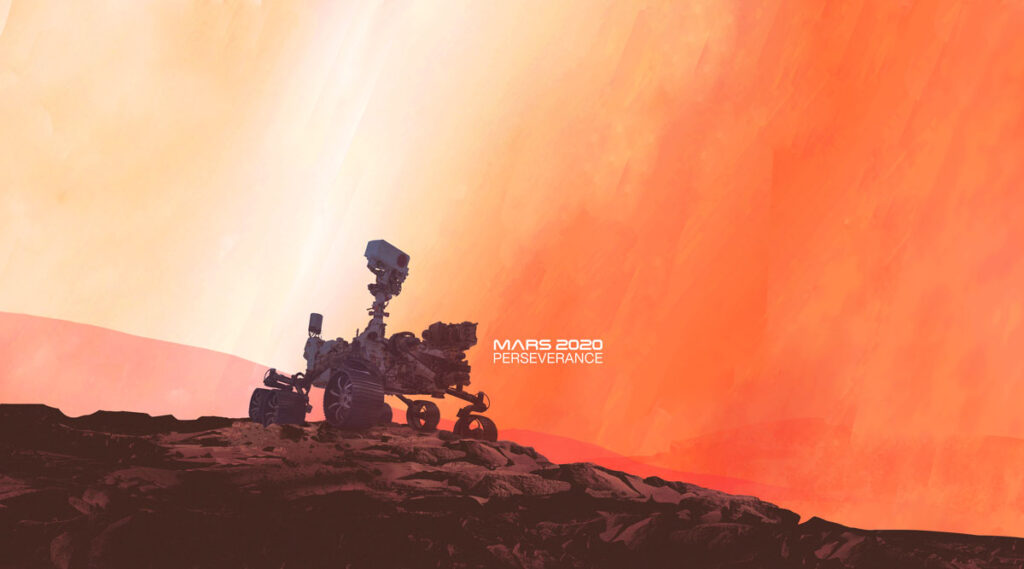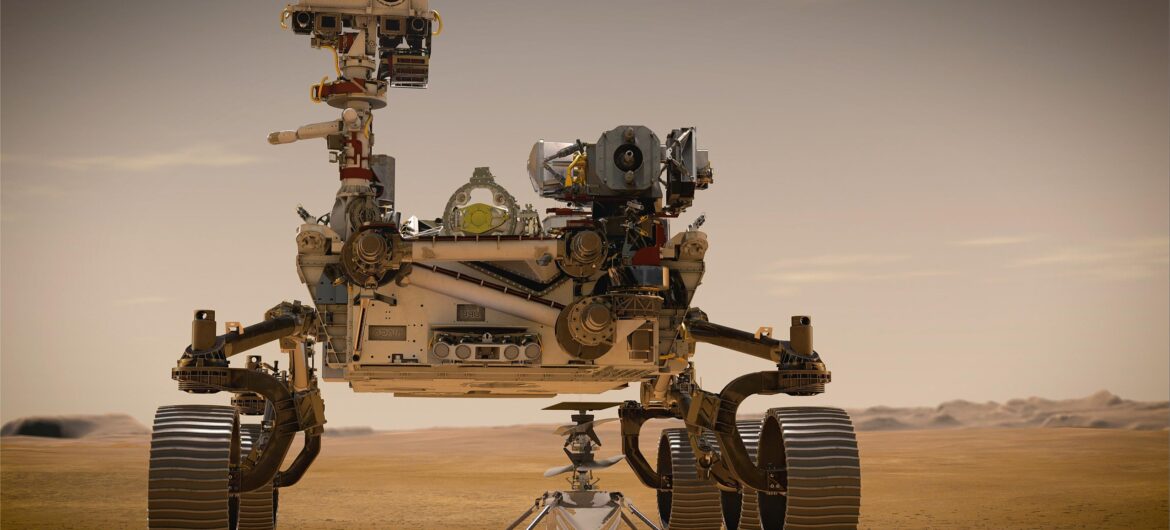Meet the six-wheeled, robotic vehicle at the forefront of space exploration and its task for finding extra- terrestrial life
Words By Rob Barrie
After eight years of planning, the Perseverance rover has finally started its long, seven-month journey through space to Mars. Encapsulated in a NASA Atlas V rocket, this autonomous vehicle launched from Cape Canaveral Air Force Station on 30 July this year. Its primary aim is to search for ancient, or perhaps even present, life on Mars. While the launching of two American astronauts to the International Space Station in May may have garnered more public interest, the importance of Perseverance’s mission is arguably far greater. Indeed its impact on the science community, and life as a whole, has the potential to be monumental.
Humanity has, for centuries, looked up to the sky in wonder, awe and trepidation of the countless glimmering lights amongst the darkness. Through technological advancement, we now know these are not of divine origin but instead, planets and stars, some in our galaxy whilst others are millions of light-years away. 1969 saw the first steps taken on land by man beyond Earth, and although Neil Armstrong’s famous line struck inspiration into the minds of those watching, technology has limited travel beyond the moon. At least, travel using a crew.
1975 saw the development of autonomous spacecraft, and thus the Viking programme was born. Although this time its target wasn’t the moon – it was Earth’s neighbour in the solar system: Mars. Two Viking landing missions were the catalyst for a further eight Mars landing missions. In 2004, these landers gave way for the more efficient and advanced “rovers.” These portable science laboratories can retrieve samples, carry out rudimentary analysis and, thanks to their wheels, travel vast distances on the surface of a planet. Perseverance is just the latest in a long line of rovers, but it is both the most sophisticated and advanced to date. It is also, arguably, the most important rover to land on the Red Planet.
While Perseverance’s design is based on that of Curiosity (the previous rover to land on Mars), it has a number of additions and modifications. It is the largest and heaviest rover to date. A large robotic arm has been fitted to enable carefully selected samples to be taken. Stronger wheels than those on Curiosity have been developed to allow travel over harsher terrain and to help bear the load of this one-tonne vehicle. For the first time in human history, we will be able to hear the Red Planet, too, as Perseverance has been fitted with multiple microphones. It will, of course, see the planet as well, thanks to 23 onboard cameras.
Image credit: Business Insider
The rover is also, remarkably, self-sustaining due to its radioisotope thermoelectric generator (MMRTG) which is, in essence, a self-charging battery. This will power Perseverance for its entire mission and allows it to travel up to 200 metres a day. The rover is designed to last one year on Mars, the equivalent of two on Earth. Finally, the rover is not travelling alone. It is travelling to Mars with a fellow robotic companion called Ingenuity, an 80cm tall helicopter drone. Its aims are to scout interesting sites with its full-colour camera and to help navigate the most efficient routes for the rover over the undulating terrain. Air on Mars is 99% less dense than on Earth, so NASA openly admit Ingenuity is, in effect, an experiment to test the viability of using drones in tandem with rovers. However, if the robotic helicopter successfully takes off, it will become the first powered flight on a planet other than Earth. For this reason, there is a lot of excitement growing around Ingenuity and its implications for future Mars missions.

This mission, however, is not merely designed to show the technological prowess of NASA. It has a wealth of equipment to aid scientific research. Probes to monitor both the atmosphere and weather and radar instruments to investigate potential hidden water beneath the surface are two examples of equipment on board. The rover also will test the viability of humans surviving on Mars by examining a new, advanced spacesuit specially designed for utilisation on Mars that it is carrying. Its main mission goal, however, is to search for life, past or present, on the Red Planet which will be done in two stages. First, Perseverance will collect various rock samples and store them in tubes which are then dropped on the surface. Although the rover is capable of rudimentary analysis, true investigation of the samples and confirmation of extraterrestrial life will happen back on Earth. The samples will be brought back on a return mission in collaboration with the European Space Agency scheduled for a 2028 launch which will most probably involve another rover picking up the tubes left behind by Perseverance.
It is known that Mars, today, has an extremely cold surface along with high radiation levels which creates a very hostile environment for life. But the Red Planet 3-4 billion years ago was vastly different: it was wetter and warmer. Geologists hypothesise that around a third of the surface of the planet was covered by oceans. Evidence for this presented itself in the form of surveys from previous Mars missions. Ancient shorelines and remnants of river features, along with Curiosity’s discovery of organic molecules (the building blocks of life) in dried-up lakes, all heavily point to a very different “Ancient Mars”. On Earth, water is, and billions of years ago were, an ingredient for life – so it seems plausible that Mars once supported life too.
It is for this reason that the Jezreo Crater was chosen as the landing site for Perseverance. After parachuting from the main module and using a thrust-driven platform to touch down on the Martian surface, the rover will find itself in a 30-mile wide crater that was once filled with water. Images of the crater show an inflow and outflow channel, meaning it was once filled with a lake billions of years ago that today forms a delta. Thus, here is a region where life, if it did develop, could have thrived. Water, coupled with a warm climate and favourable atmospheric conditions, means all the ingredients for early forms of life existed concurrently. And if life did indeed develop, there would be evidence of this on present-day Mars in the form of microbial microfossils. Such microfossils embedded within rocks are exactly what Perseverance is tasked with collecting and why Jezreo Crater is such an ideal and scientifically exciting place to study.
There have been critics bemoaning the search for life on Mars as a waste of both money and resources, but the hunt for life beyond our planet is well-founded. Rocks within the crater are hypothesised to be as old as when life first started to flourish on Earth, so the parallel occurrence of life on separate, neighbouring planets has implications for other planets or moons with similar conditions. If signatures of ancient life are detected, it would cause huge implications for life beyond our galaxy too. Indeed, as scientists suggest, if life had spontaneously occurred on two independent planets in the same solar system, then the chances of life appearing in other corners of the universe are extremely high.
In seven month’s time when this six-wheeled rover at the forefront of human space exploration sets down on Mars, our understanding of life beyond Earth will begin. And while previous rover missions simply investigated if life on Mars could be supported, Perseverance will investigate if life did, or even does, exist. 2031, the year when the Martian rock samples return to Earth, shall be a date to save in calendars for it will be the year when science will be able to confirm with irrefutable evidence whether there really is alien life on Mars.





